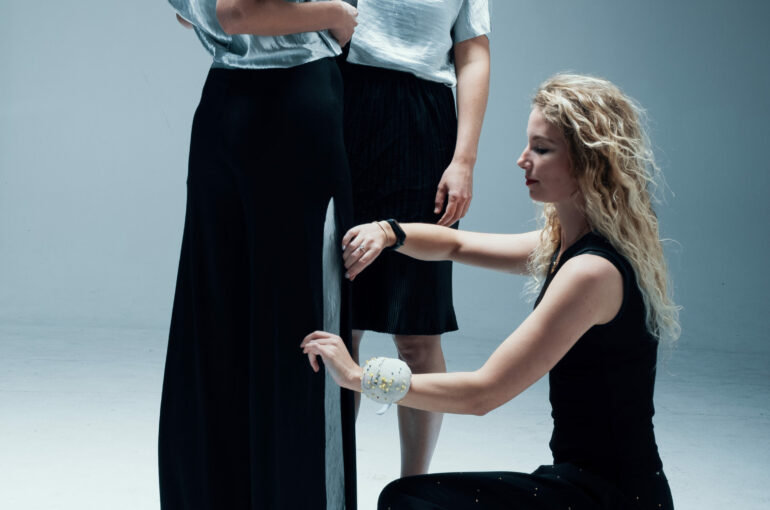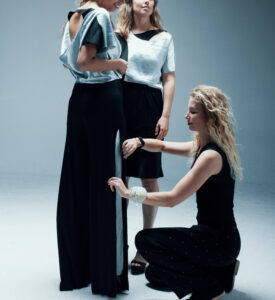RE-FREAM project 2021: Second Skins

Over the next 9 months I will share an inside pic into our Re-FREAM project Second Skin via this platform. To give you a first impression of the project and the concept, I would like to tell you about the broader mindflow behind it.
There are a few questions that have kept my mind occupied over the past few years. These questions are constantly popping up in different forms and are the base framework for my work. In this blog post, I will share some of these questions and their underlying thoughts, which also form the core of the concept and motivation for this current project.
How is it possible that we keep surrounding ourselves with passive and polluting garments while the world we live in becomes “smarter” every day?
In the morning we still need to pick an outfit that needs to suit us throughout the whole day, without knowing what kind of situations we will encounter. This feels old-fashioned in an era in which the rise of “Smart Things” and data-collecting gadgets is a fact.
The recent fast fashion movement is based on the desire for quick changes in the wardrobe. How amazing would it be if we could change and customize the colors, patterns, structures, and other properties of our clothing? If we wouldn’t have the constant need for new items anymore, as we can simply change the content and attributes of a product instead? This can truly enhance the life span of the pieces we own. And therefore, become a valuable and sustainable solution.
Is it possible to reshape the relation between garment and wearer by using a new approach within the design of clothing?
Fashion is, due to its practical values (warmth, protection etc.) and natural position close to the body, the most personal and intimate form of design. Therefore, it is an essential and vital communication tool. Nonetheless, besides new material development and production upscaling for fast fashion, the framework and approach of clothing design have hardly changed over de past decades.
However, our relationship with our clothes has changed dramatically. Due to the industrialization and globalization of the industry, it went from personal, custom made, hand-tailored, valuable, sustainable items to cheap, disposable and fast products. But this doesn’t mean that the core values of clothing have changed. It is only the narrative that has shifted. This made me wonder if we can reshape this relationship with the fusion of fashion and tech by using a new design approach, which brings us to the next question.
Why are we often still designing on static mannequins in passive postures in the fashion industry?
Only when clothes are being worn on the body they communicate to their fullest extent, by the way they are being worn. So, if we design for a human being for whom it is essential to communicate by movement, why are we often still designing on static mannequins in passive postures? I am convinced that it is fundamental to start designing from a human-centric point of view by integrating the knowledge on nonverbal behaviour into the design process.
Dictating designers that are reshaping the body in artificial shapes and positions, do it for the sake of it and while this comprises a prominent part of fashion, it is also an outdated perspective. Let’s start exploring new design strategies that are no longer about developing passive shells, but about creating dynamic and responsive items that fuse together with the wearer. This asks for a different way of design thinking; a way that is user-based. Using a human-centric approach that embraces and uses human behaviour and movement is a well-known vantage point within other design disciplines, but within fashion design it is an underdeveloped discipline. Imagine that wearables, specifically our clothing, would be able to become a second skin that fluently communicates and transforms with us. An extra skin that adapts to internal signals and body language, as well as to external factors from environmental changes.
How can wearable tech enhance our human communication and social interaction?
Currently, the focus of a lot of integrated wearable tech projects is oriented in the fields of healthcare, sports and safety. Often it is ‘form follows function’-based, which is useful and necessary but often lacking on a human-centric and communicational level. Therefore, within this project, we will investigate the possibilities of developing reactive second skins with a central focus on sociology, human behaviour and communication.
Striving for a fluid and seamless fusion of wearer and wearable so that they communicate as one total being is a challenge, but–also in the long run–the ultimate goal. Regarding non-verbal communication and interaction, we see amazing examples in the animal world and nature. Looking at the communication tools and the adaptive and transformational skills within nature, will be a core inspiration for the process as we will try to translate biomimicry into a fashion and tech hybrid.
The base of my design approach is the collaboration of different fields within interdisciplinary projects. In my opinion, this is the future, because it is within these intersections where innovation takes place and where the magic happens. Somehow the mainstream fashion industry is pretty resistant and has stayed behind in these developments. Combining wearables with psychology, social studies, new technology and material development can push the industry to the next level. That is why I have always worked on interdisciplinary projects. Finding common ground and learning to understand each other’s way of thinking are vital elements for triggering your own creativity. There’s a whole realm within these intersections that is waiting to be explored.
Therefore, Re-FREAM is a great fit and perfectly aligned with my vision. I am delighted that I am able to research these subjects over the next few months, with a passioned and driven interdisciplinary team. Partners in this team are Agnieszka Psikuta from EMPA, Christian Dils, Max Marwede, Robin Hoske and Tapani Jokinen from IZM Fraunhofer and Pavel Kulha from Profactor. We will be working from our main hub Wear It Berlin.
Stay tuned and follow our journey over the next 9 months.

Photographer: Patrick Klein Meuleman
Links to related websites:
Malou Beemer: http://www.maloubeemer.com/
IZM Fraunhofer: https://www.izm.fraunhofer.de/
EMPA: https://www.empa.ch/
Profactor: https://www.profactor.at/
Wear It Berlin: https://www.wearit-berlin.com/





